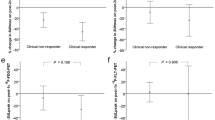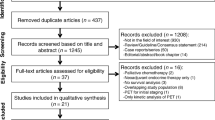Abstract
Purpose
The purpose of this pilot study was to assess whether outcome in metastatic or recurrent breast cancer patients is related to metabolic response to endocrine therapy determined by 18F-FDG PET/CT.
Methods
The study group comprised 22 patients with breast cancer (age 58 ± 11 years, mean ± SD) who were scheduled to receive endocrine therapy. They were systematically assessed by PET/CT at baseline and after a mean of 10 ± 4 weeks for evaluation of response after induction. All patients demonstrated FDG-avid lesions on the baseline PET/CT scan. The metabolic response was assessed according to EORTC criteria and based on the mean difference in SUVmax between the two PET/CT scans, and the patients were classified into four groups: complete or partial metabolic response, or stable or progressive metabolic disease (CMR, PMR, SMD and PMD, respectively). All patients were followed in our institution.
Results
Metastatic sites were localized in bone (n = 15), lymph nodes (n = 11), chest wall (n = 3), breast (n = 5), lung (n = 3), soft tissue (n = 1) and liver (n = 1). PMR was observed in 11 patients (50%), SMD in 5 (23%) and PMD in 6 (27%). The median progression-free survival (PFS) times were 20, 27 and 6 months in the PMR, SMD and PMD groups, respectively. PFS in the SMD group differed from that in the PMR and SMD groups (p < 0.0001).
Conclusion
Metabolic response assessed by FDG PET/CT imaging in patients with metastatic breast cancer treated with endocrine therapy is predictive of the patients’ PFS.






Similar content being viewed by others
References
Beslija S, Bonneterre J, Burstein H, Cocquyt V, Gnant M, Heinemann V, et al.; Central European Cooperative Oncology Group (CECOG). Third consensus on medical treatment of metastatic breast cancer. Ann Oncol. 2009;20:1771–85.
Kuukasjärvi T, Kononen J, Helin H, Holli K, Isola J. Loss of estrogen receptor in recurrent breast cancer is associated with poor response to endocrine therapy. J Clin Oncol. 1996;14:2584–9.
Kaufmann M, von Minckwitz G, Bear H, Buzdar A, McGale P, Bonnefoi H, et al. Recommendations from an international expert panel on the use of neoadjuvant (primary) systemic treatment of operable breast cancer: new perspectives 2006. Ann Oncol. 2007;18:1927–34.
Schelling M, Avril N, Nahrig J, Kuhn W, Romer W, Sattler D. Positron emission tomography using [(18)F]fluorodeoxyglucose for monitoring primary chemotherapy in breast cancer. J Clin Oncol. 2000;18:1689–95.
Smith I, Welch A, Hutcheon A, Miller I, Payne S, Chilcott F. Positron emission tomography using [(18)]-(fluorine-18)-fluorodeoxy-D-glucose to predict the pathologic response of breast cancer to primary chemotherapy. J Clin Oncol. 2000;18:1676–88.
Rousseau C, Devillers A, Sagan C, Ferrer L, Bridji B, Campion L, et al. Monitoring of early response to neoadjuvant chemotherapy in stage II and III breast cancer by [18F]fluorodeoxyglucose positron emission tomography. J Clin Oncol. 2006;24:5366–72.
Berriolo-Riedinger A, Touzery C, Riedinger JM, Toubeau M, Coudert B, Arnould L, et al. [18F]FDG-PET predicts complete pathological response of breast cancer to neoadjuvant chemotherapy. Eur J Nucl Med Mol Imaging. 2007;34:1915–24.
McDermott G, Welch A, Staff R, Gilbert F, Schweiger L, Semple S, et al. Monitoring primary breast cancer throughout chemotherapy using FDG-PET. Breast Cancer Res Treat. 2007;102(1):75–84.
Schwarz-Dose J, Untch M, Tiling R, Sassen S, Mahner S, Kahlert S, et al. Monitoring primary systemic therapy of large and locally advanced breast cancer by using sequential positron emission tomography imaging with [18F]fluorodeoxyglucose. J Clin Oncol. 2009;27:535–41.
Duch J, Fuster D, Munoz M, Fernandez PL, Paredes P, Fontanillas M, et al. 18F-FDG PET/CT for early prediction of response to neoadjuvant chemotherapy in breast cancer. Eur J Nucl Med Mol Imaging. 2009;36:1551–7.
Dose Schwarz J, Bader M, Jenicke L, Hemminger G, Jänicke F, Avril N. Early prediction of response to chemotherapy in metastatic breast cancer using sequential 18F-FDG PET. J Nucl Med. 2005;46:1144–50.
Couturier O, Jerusalem G, N’Guyen J, Hustinx R. Sequential positron emission tomography using [18F]fluorodeoxyglucose for monitoring response to chemotherapy in metastatic breast cancer. Clin Cancer Res. 2006;12:6437–43.
Specht J, Tam S, Kurland B, Gralow J, Livingston R, Linden H, et al. Serial 2-[18F] fluoro-2-deoxy-D-glucose positron emission tomography (FDG-PET) to monitor treatment of bone-dominant metastatic breast cancer predicts time to progression (TTP). Breast Cancer Res Treat. 2007;105:87–94.
Dehdashti F, Flanagan F, Mortimer J, Katzenellenbogen J, Welch M, Siegel B. Positron emission tomographic assessment of “metabolic flare” to predict response of metastatic breast cancer to antiestrogen therapy. Eur J Nucl Med. 1999;26:51–6.
Mortimer J, Dehdashti F, Siegel B, Trinkaus K, Katzenellenbogen J, Welch M. Metabolic flare: indicator of hormone responsiveness in advanced breast cancer. J Clin Oncol. 2001;19:2797–803.
Young H, Baum R, Cremerius U, Herholz K, Hoekstra O, Lammertsma A, et al. Measurement of clinical and subclinical tumour response using [18F]-fluorodeoxyglucose and positron emission tomography: review and 1999 EORTC recommendations. European Organization for Research and Treatment of Cancer (EORTC) PET Study Group. Eur J Cancer. 1999;35:1773–82.
Kaplan E, Meier P. Nonparametric estimation from incomplete observations. J Am Stat Assoc. 1958;53:457–81.
Hamaoka T, Madewell J, Podoloff D, Hortobagyi G, Ueno N. Bone imaging in metastatic breast cancer. J Clin Oncol. 2004;22:2942–53.
Du Y, Cullum I, Illidge T, Ell P. Fusion of metabolic function and morphology: sequential [18F]fluorodeoxyglucose positron-emission tomography/computed tomography studies yield new insights into the natural history of bone metastases in breast cancer. J Clin Oncol. 2007;25:3440–7.
Tateishi U, Gamez C, Dawood S, Yeung H, Cristofanilli M, Macapinlac H. Bone metastases in patients with metastatic breast cancer: morphologic and metabolic monitoring of systemic therapy with integrated PET/CT. Radiology. 2008;247:189–96.
Schneider-Kolsky M, Hart S, Fox J, Midolo P, Stuckey J, Hofman M, et al. The role of chemotherapeutic drugs in the evaluation of breast tumour response to chemotherapy using serial FDG-PET. Breast Cancer Res. 2010;12:R37.
Ueda S, Tsuda H, Saeki T, Omata J, Osaki A, Shigekawa T, et al. Early metabolic response to neoadjuvant letrozole, measured by FDG PET/CT, is correlated with a decrease in the Ki67 labeling index in patients with hormone receptor-positive primary breast cancer: a pilot study. Breast Cancer. 2010;16:660–2.
Bos R, van Der Hoeven J, van Der Wall E, van Der Groep P, van Diest P, Comans E, et al. Biologic correlates of (18)fluorodeoxyglucose uptake in human breast cancer measured by positron emission tomography. J Clin Oncol. 2002;15:379–87.
Buck A, Schirrmeister H, Kuhn T, Shen C, Kalker T, Kotzerke J, et al. FDG uptake in breast cancer: correlation with biological and clinical prognostic parameters. Eur J Nucl Med Mol Imaging. 2002;29:1317–23.
Shimoda W, Hayashi M, Murakami K, Oyama T, Sunagawa M. The relationship between FDG uptake in PET scans and biological behavior in breast cancer. Breast Cancer. 2007;14:260–8.
Smith I, Dowsett M, Ebbs S, Dixon J, Skene A, Blohmer J, et al. Neoadjuvant treatment of postmenopausal breast cancer with anastrozole, tamoxifen, or both in combination: the Immediate Preoperative Anastrozole, Tamoxifen, or Combined with Tamoxifen (IMPACT) multicenter double-blind randomized trial. J Clin Oncol. 2005;23:5108–16.
Dowsett M, Smith I, Ebbs S, Dixon J, Skene A, Griffith C, et al. Proliferation and apoptosis as markers of benefit in neoadjuvant endocrine therapy of breast cancer. Clin Cancer Res. 2006;12:1024s–30s.
Dowsett M, Smith I, Ebbs S, Dixon J, Skene A, A’Hern R, et al. Prognostic value of Ki67 expression after short-term presurgical endocrine therapy for primary breast cancer. J Natl Cancer Inst. 2007;99:167–70.
Huyge V, Garcia C, Alexiou J, Ameye L, Vanderlinden B, Lemort M, et al. Heterogeneity of metabolic response to systemic therapy in metastatic breast cancer patients. Clin Oncol (R Coll Radiol). 2010;22:818–27.
Champion L, Brain E, Giraudet A, Le Stanc E, Wartski M, Edeline V, et al. Breast cancer recurrence diagnosis suspected on tumor marker rising: value of whole-body 18FDG-PET/CT imaging and impact on patient management. Cancer. 2011;117:1621–9.
Harris L, Fritsche H, Mennel R, Norton L, Ravdin P, Taube S, et al; American Society of Clinical Oncology. American Society of Clinical Oncology 2007 update of recommendations for the use of tumor markers in breast cancer. J Clin Oncol. 2007;25:5287–312.
Ellis M, Coop A, Singh B, Mauriac L, Llombert-Cussac A, Jänicke F, et al. Letrozole is more effective neoadjuvant endocrine therapy than tamoxifen for ErbB-1- and/or ErbB-2-positive, estrogen receptor-positive primary breast cancer: evidence from a phase III randomized trial. J Clin Oncol. 2001;19:3808–16.
Mintun M, Welch M, Siegel B, Mathias C, Brodack J, McGuire A, et al. Breast cancer: PET imaging of estrogen receptors. Radiology. 1988;169:45–8.
McGuire A, Dehdashti F, Siegel B, Lyss A, Brodack J, Mathias C, et al. Positron tomographic assessment of 16a-[18F]fluoro-17b-estradiol uptake in metastatic breast carcinoma. J Nucl Med. 1991;32:1526–31.
Linden H, Stekhova S, Link J, Gralow J, Livingston R, Ellis G, et al. Quantitative fluoroestradiol positron emission tomography imaging predicts response to endocrine treatment in breast cancer. J Clin Oncol. 2006;24:2793–9.
Dehdashti F, Mortimer J, Trinkaus K, Naughton M, Ellis M, Katzenellenbogen J, et al. PET-based estradiol challenge as a predictive biomarker of response to endocrine therapy in women with estrogen-receptor-positive breast cancer. Breast Cancer Res Treat. 2009;113:509–17.
Ko B, Paik J, Jung K, Lee K. 17b-Estradiol augments 18F-FDG uptake and glycolysis of T47D breast cancer cells via membrane-initiated rapid PI3K-Akt activation. J Nucl Med. 2010;51:1740–7.
Pio BS, Park CK, Pietras R, Hsueh WA, Satyamurthy N, Pegram MD, et al. Usefulness of 3′-[F-18]fluoro-3′-deoxythymidine with positron emission tomography in predicting breast cancer response to therapy. Mol Imaging Biol. 2006;8:36–42.
Kenny L, Coombes RC, Vigushin DM, Al-Nahhas A, Shousha S, Aboagye EO. Imaging early changes in proliferation at 1 week post chemotherapy: a pilot study in breast cancer patients with 3′-deoxy-3′-[(18)F]fluorothymidine positron emission tomography. Eur J Nucl Med Mol Imaging. 2007;34:1339–47.
Lindholm P, Lapela M, Någren K, Lehikoinen P, Minn H, Jyrkkiö S. Preliminary study of carbon-11 methionine PET in the evaluation of early response to therapy in advanced breast cancer. Nucl Med Commun. 2009;30:30–6.
Conflicts of interest
None.
Author information
Authors and Affiliations
Corresponding author
Additional information
A related editorial commentary can be found at doi:10.1007/s00259-011-2018-3.
Rights and permissions
About this article
Cite this article
Mortazavi-Jehanno, N., Giraudet, AL., Champion, L. et al. Assessment of response to endocrine therapy using FDG PET/CT in metastatic breast cancer: a pilot study. Eur J Nucl Med Mol Imaging 39, 450–460 (2012). https://doi.org/10.1007/s00259-011-1981-z
Received:
Accepted:
Published:
Issue Date:
DOI: https://doi.org/10.1007/s00259-011-1981-z




